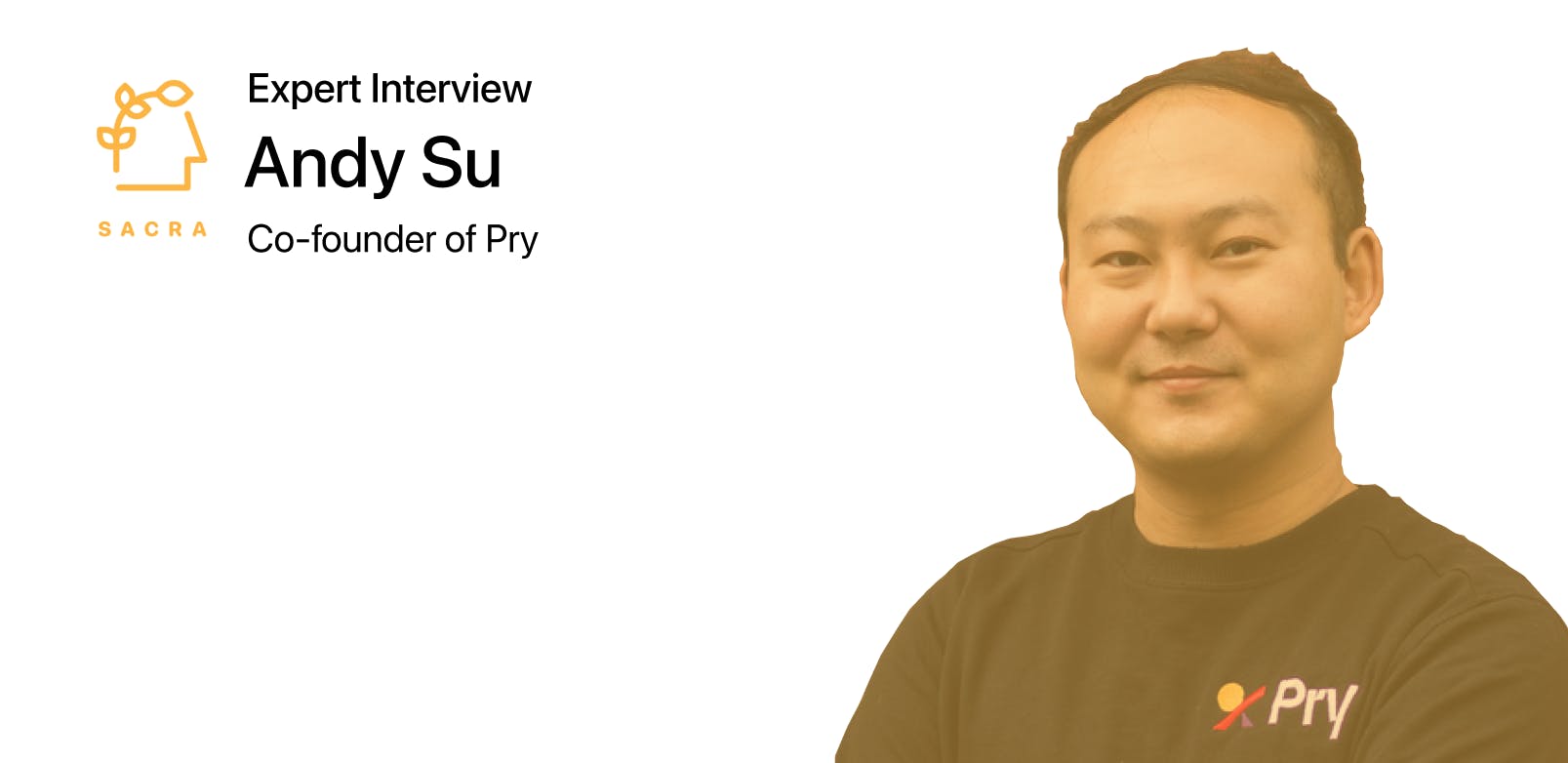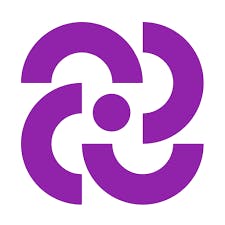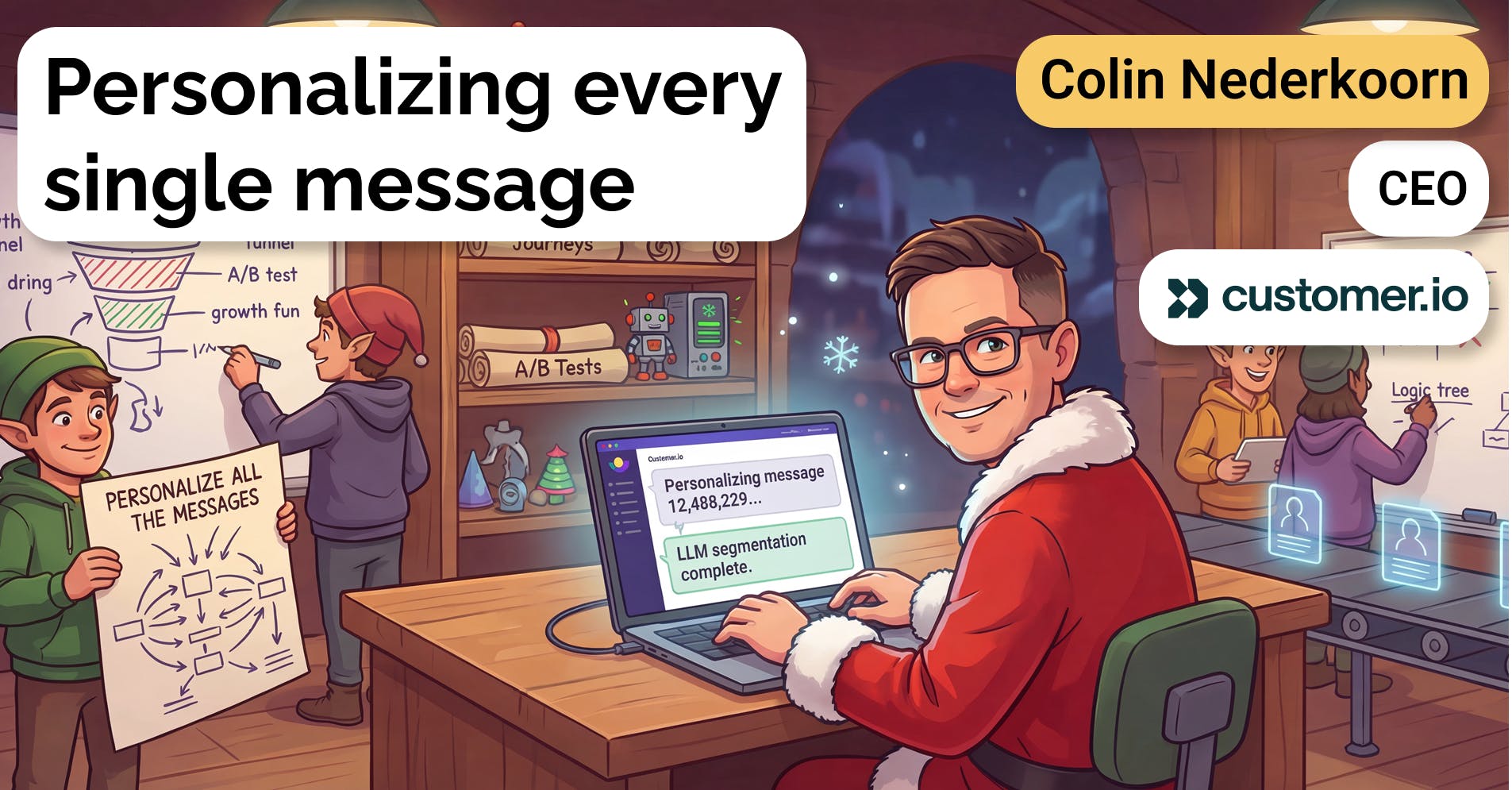Andy Su, co-founder of Pry, on building the "Figma of finance"
 Conor Gleeson
Conor Gleeson

Background
Andy Su is the CEO and co-founder of Pry. Previously, he was the CEO and co-founder of inDinero. We talked with Andy because of several big trends that Pry is part of: 1) fintech companies using the corporate card as a point of integration to expand into FP&A, expense management, travel, and others, and 2) the increasing digitization of the finance back-office with tools like Plaid, Gusto, Rippling, and others.
Questions
- Can you start off by talking about Pry -- the problem you're solving, your customer profile, and the core use case that drives adoption?
- Can you share some of the early signs that you have product/market fit?
- In recent years, we've seen the digital transformation of finance back office with tools like Plaid digitizing banking, Gusto, Rippling, and Justworks taking over payroll, Stripe for payments, and more. Can you talk about the trends you've seen for why customers choose these tools, how they choose between the tools, and how they assemble their stacks?
- So the current default FP&A tool might be a spreadsheet in Excel, but versioning, permissioning, and collaborating can be challenging in Excel and Google Sheets. Can you talk about what you think about both go-to-market and product for Pry against a broad-based tool with wide adoption, like Excel or Google Sheets?
- FP&A works as an application on top of bookkeeping, which makes Pry dependent on infrastructure-like products like QuickBooks and Xero. What do you think about your positioning with respect to QuickBooks and Xero, and how do you think about partnering with/competing against them, both on FP&A and bookkeeping software?
- As you mentioned, you co-founded inDinero, an early software-enabled bookkeeping service. Companies like Pilot are the latest iteration of this approach, where they also offer FP&A as a part of their fractional CFO services. Similar to bookkeeping software, these are also potential partners and competitors. How do you think about the bookkeeping services space, particularly on its ability to get close to the customer and to direct the customer to its own favored software and services? Is Pilot in the position to move customers off QuickBooks or Pry onto its own bookkeeping software, and how do you think about that?
- In recent years, there's been a surge of startups tackling FP&A, including Pry, Digits, Runway, Causal, Mosaic, Finmark, and more. Can you talk about the trends behind why founders want to build in this space and how you segment out?
- How do you think about the positioning of Pry against FP&A tools like Anaplan, Planful, and Adaptive Planning?
- I would love to hear what you think about enterprise FP&A products like NetSuite, the feedback you hear from their customers, and what opportunities and tailwinds there are for disruption. Obviously different market segments right now, but you're still functioning beside them.
- Via their integration with the corporate card, Brex and Ramp can automatically handle a company's expense management. How do you think about their ability to expand into FP&A by using that integration point around the card and about the vision for a consolidated finance back office under a single tool? And what do you think the company that wins here will do?
- On the flip side, Pry and FP&A software can offer virtual cards that are tied to budget and can automatically reconcile spend. How do you think about moving into the expense management side? How do you think more generally about offering financial services elsewhere in the stack -- e.g., underwriting loans like Stripe Capital -- and what an FP&A product might be positioned to offer?
- Companies used to manually replicate their payroll inside their FP&A tool to do financial planning. Now companies like Gusto are building out payroll APIs, and companies like Finch offer payroll APIs to a number of providers. Can you talk about programmatic payroll as enabling the opportunity for Pry, and do you think that Pry will close a loop on the hiring plan by building its own payroll product inside of the FP&A using a product?
- There's no “Figma for finance,” as it were, but we know finance is a highly collaborative activity, both within a company and with external bookkeepers, advisors, and stakeholders. Can you talk about how you think about finance collaboration, the challenges in building it, and the potential for seat expansion, if not wall-to-wall adoption, within a company?
- FP&A is an important integration point where you can connect your financial tools and interoperable tools. APIs have created an opportunity for Pry, but also increased data portability and lowered switching costs as well. How do you think about customer lock-in and minimizing churn, and what do you think your competitive moat is as you scale?
- FP&A looks very different in an early-stage company versus growth-stage versus pre-IPO versus public. The entry point of customers into Pry is often at the earliest stages -- you mentioned going into Series B. Can you talk about Pry’s ability to scale as a company grows, where you see the break points, and how Pry might move beyond those to reach enterprise scale?
- Is there anything else you hoped we’d cover or you want to make sure we include?
Interview
Can you start off by talking about Pry -- the problem you're solving, your customer profile, and the core use case that drives adoption?
Pry is, in a nutshell, financial planning for startups. We help startups build a financial plan, and startups need this in order to raise money or to operate. They want to know when they're going to run out of cash -- at three months, six months, eight months, and so on. Our customers started off as very small bootstrap or pre-seed companies with no revenue.
That's what we first built for, because they had simpler use cases. And now we're able to take care of companies that have raised a seed, Series A or Series B -- so pretty sizable companies of up to 100 or 150 employees.
Can you share some of the early signs that you have product/market fit?
I still don't know if we have product/market fit, according to the Andreessen blog. Reporters aren't banging on my door trying to knock it down. They're not calling me and stalking me yet. So I don't know if we've got product/market fit. But we do have 360 customers, and that makes me feel like we've got something real here. We’re solving a real problem. And that number -- when I say it now, it sounds amazing, but I was proud to have 20. I was really excited when we got our first 20, then 50, then 100, then 150, and now we're at 360. So that's a good indication we're onto something.
Maybe a little bit earlier on, in roughly September 2020, we found our first really happy customer. He set up everything by himself and asked us really good questions. He just absolutely loved our product. He wanted to pay more than we were charging, and he sent it to his buddies all over the place. And I distinctly remember that guy, Chris. He really made our day because before then, we were just building something that we didn’t know if people wanted for more than a year. So when you get your first really happy customer, I think that's when you really can tell that you might have something.
In recent years, we've seen the digital transformation of finance back office with tools like Plaid digitizing banking, Gusto, Rippling, and Justworks taking over payroll, Stripe for payments, and more. Can you talk about the trends you've seen for why customers choose these tools, how they choose between the tools, and how they assemble their stacks?
So startup founders don't really care about finance. They just want to get it done. Their goal is to launch that rocket or cure cancer or whatever it is their product is supposed to be. So they go for the easiest solution, but they also look for something that's scalable. Stripe, for instance, is easy, and it's also scalable. Same with Gusto, same with many of the tools you listed.
As a founder, you want to find a finance stack that works well together because, otherwise, you're going to need to rip things out, and that's a pain. Most people know that Gusto will work well with a lot of tools, so that's where the brand comes in at some point. I think people use these tools because they’re easy to set up. It's simple.
Hopefully Pry will be added to that list because we've made it approachable and integrated and simple for folks. You've listed a lot of tools, but there isn't really something for FP&A. Everyone is still using Google Sheets or Microsoft Excel.
So the current default FP&A tool might be a spreadsheet in Excel, but versioning, permissioning, and collaborating can be challenging in Excel and Google Sheets. Can you talk about what you think about both go-to-market and product for Pry against a broad-based tool with wide adoption, like Excel or Google Sheets?
Go-to-market is really challenging for our company, mostly because Excel is so widely used, but I've learned a lot from Carta. A decade ago, cap tables were all in Excel. Now Carta exists, and I don't have my cap table in Excel anymore. I can export it to Excel and send it to lawyers, and it’s accepted. But I don't have to be working on an Excel cap table anymore.
A lot of what they've done, I think we can incorporate in our go-to-market strategy. For instance, familiarize CPAs with our product or offer something else that's used for incorporation, like a 409A valuation, to get people in the door. For Carta, it's a 409A valuation, but for us, it might be something like a setup from scratch -- something that investors will be excited to see. A lot of startup founders probably have no idea how to set up a financial forecast, and we're able to give that to them for a very affordable cost.
FP&A works as an application on top of bookkeeping, which makes Pry dependent on infrastructure-like products like QuickBooks and Xero. What do you think about your positioning with respect to QuickBooks and Xero, and how do you think about partnering with/competing against them, both on FP&A and bookkeeping software?
First of all, I have no intention of building accounting software. I tried doing that in my last company inDinero, and now I'm definitely over it.
I think QuickBooks and Xero are excellent tools, and they integrate well with other companies. There are some challenges sometimes with the integration, like a user might come to our site and see that something's wrong, and it's actually wrong in QuickBooks. But if it's wrong in QuickBooks, it's usually because the person who is responsible -- the accountant -- didn't do it right. So it's ultimately still a person's fault when you track that down. It's not because the software was doing anything wrong. So I think in that respect, I can see Pry working with QuickBooks and Xero long term.
I think QuickBooks and Xero have both tried building budgeting apps into their systems, but we're able to move faster and more agilely. So we'll be able to have our own space there. And ultimately, I think this is to QuickBooks’ benefit: we're enabling QuickBooks companies to punch up, to delay that switch to NetSuite or Anaplan. I can see a stack where QuickBooks and Pry work for larger businesses, so those companies don't need to pay those large enterprise contracts. They can just stick with the tools they’ve been using.
As you mentioned, you co-founded inDinero, an early software-enabled bookkeeping service. Companies like Pilot are the latest iteration of this approach, where they also offer FP&A as a part of their fractional CFO services. Similar to bookkeeping software, these are also potential partners and competitors. How do you think about the bookkeeping services space, particularly on its ability to get close to the customer and to direct the customer to its own favored software and services? Is Pilot in the position to move customers off QuickBooks or Pry onto its own bookkeeping software, and how do you think about that?
I spoke to Waseem, and he's very adamant about not doing that and just using different tools. And as far as I can see, he's true to his word there, so I don't think they're building a QuickBooks replacement somewhere behind the curtains.
That said, they definitely have the ability to influence the decisions that can make people move from QuickBooks to Xero. But having run inDinero before, I know that that's hugely disruptive. Pilot now has been training their entire staff on QuickBooks for many, many years. To switch to another accounting system would cause them way more problems than it's worth.
So that’s not really a fear of mine, for Pilot to move out of Pry. What I'm trying to get them to do is to move out of Excel onto Pry. That's hard because, like we said, they've been training their CFO team on Excel for years. That change is going to be slow and gradual. But ultimately, if we provide enough value in our platform -- or any FP&A platform, for that matter -- then companies like Pilot will have to move in order to compete and stay competitive. That's what I have my eye on -- just creating a ton of value.
In recent years, there's been a surge of startups tackling FP&A, including Pry, Digits, Runway, Causal, Mosaic, Finmark, and more. Can you talk about the trends behind why founders want to build in this space and how you segment out?
I think almost every second-time founder wants to build this, because you know the best type of company to build is to build something that solves a problem you've lived. And every first-time founder has lived this problem, which is why every second-time founder wants to build this. That said, I think I’m one of the best people to build this because my previous experience was inDinero, and I saw this process -- not just for my own company, but for hundreds of customers. And on top of that, I led both finance and product internally at inDinero.
The other reason why a lot of people want to do this is because technology has finally made it so that this is the right time to build something like this. QuickBooks and Xero APIs were non-existent, or just really poorly developed , back in 2015, 2016. And now it's becoming more and more open. There are payroll APIs you can connect to, like we do with Finch. That was built only a couple of years ago.
So there are a lot of reasons why right now is the best time to build. And also why for every second-time founder -- they’ve lived this problem before; they've had to deal with it.
How do you think about the positioning of Pry against FP&A tools like Anaplan, Planful, and Adaptive Planning?
We really want to make product-led growth work. We've got a free plan, and our basic plan is $50 a month. That’s nowhere near the enterprise pricing of Anaplan and these folks you mentioned. So I don't think we're going to see them on the market for years.
And I do think Pry scales. Before, when we first launched our features, we were only good for bootstrapped, simple companies. Now we're getting better and better. We've just launched a very robust sharing and teams feature. We're getting our SOC 2 compliance as well. And we're able to take on larger and larger companies every year.
But it will still take many years before we run up against the likes of Anaplan, so I'm not too worried about it right now. Also, I don't think they’ll lower their pricing to compete with us. That's just not feasible for their product and structure.
I would love to hear what you think about enterprise FP&A products like NetSuite, the feedback you hear from their customers, and what opportunities and tailwinds there are for disruption. Obviously different market segments right now, but you're still functioning beside them.
NetSuite is not quite what we do. They’re an ERP. We don't integrate with NetSuite, so we don't really have a lot of direct feedback. I’ve met a couple of CFOs who use NetSuite, and the general feedback is NetSuite is not the best piece of software. It's the only piece of software, and that's why people use it.
So I believe there's a lot of room for disruption. As for how to disrupt NetSuite? You’ve got to build an ERP; you have to do a lot of build. I think in the future Pry will run up against ERP platforms like NetSuite. You move off of QuickBooks onto NetSuite when you're a certain size. You do that when there are things you can't do in QuickBooks anymore, or it’s getting too slow, or you're using QuickBooks and you're also using an Excel sheet that is your actual source of truth. Once that gets too painful, then you move to NetSuite.
What we hope is we replace that Excel spreadsheet. You’re using Pry plus QuickBooks, and for many companies you don't need to use an ERP at all. That's what we're trying to get to. Pry plus QuickBooks or Pry plus Xero means you don't need an ERP . You don't need a mid-market tool. And that’s our mission.
Via their integration with the corporate card, Brex and Ramp can automatically handle a company's expense management. How do you think about their ability to expand into FP&A by using that integration point around the card and about the vision for a consolidated finance back office under a single tool? And what do you think the company that wins here will do?
Well, I'll try to speak directly to Brex and Ramp. It seems like they've got a venture-backed sector, and they're also taking on Concur in the bill pay section.
FP&A is certainly something that I think they can build and would be exciting and interesting for them to build. But I'm not worried because FP&A is such a large market. There should be multiple players that win. So if Brex or Ramp decides to build here, then it'll further validate that there's something here and that we will eventually do quite well. We’re improving upon Excel, which is a huge market.
On the flip side, Pry and FP&A software can offer virtual cards that are tied to budget and can automatically reconcile spend. How do you think about moving into the expense management side? How do you think more generally about offering financial services elsewhere in the stack -- e.g., underwriting loans like Stripe Capital -- and what an FP&A product might be positioned to offer?
Right now, Pry doesn’t offer this sort of “budget and it ties to your card” reconciliation yet. We tested out the feature, and it works really great for me, but there's a lot of work to be done to make sure that the feature works.
Pry is currently making money off of subscriptions. Clients pay us a SaaS fee. But down the line, we’re very interested in offering payment solutions, and we're very interested in helping out in the lending process. And that's because we think we've got the best data. We've got bank data and card data, and not only that -- we have your future forecast and your business model. Pry should be in the best position to advise our companies, and that's what I want to get to.
Our mission at inDinero was to automate the CFO, and it's in some sense still here with me at Pry. What we want to do is standardize how finances are run and then provide this data back to our users so they can better run their company. After we standardize the financial plans for our customers, we'll be able to offer lending on top of that -- so offer something good for what our algorithm expects are better companies. That's really interesting to me.
You know we’re a Y Combinator company. Y Combinator is doing very well, but if you think about it, it's a services company. They have partners who spend a significant amount of their time helping companies build and scale. So what would an automated version of Y Combinator be? That's what I've been asking myself, and it would probably be something that looks a lot like Pry.
Companies used to manually replicate their payroll inside their FP&A tool to do financial planning. Now companies like Gusto are building out payroll APIs, and companies like Finch offer payroll APIs to a number of providers. Can you talk about programmatic payroll as enabling the opportunity for Pry, and do you think that Pry will close a loop on the hiring plan by building its own payroll product inside of the FP&A using a product?
I want to avoid building too many things. Like I mentioned before, I don't want to build QuickBooks. Similarly, I don't want to build Gusto. And this is because there's so much for us to do on the FP&A front already.
But this is a helpful tool for our users. Off the top of my head right now -- and not saying that this is what we're going to do -- if there are enough Gusto users, or if there's somebody who hasn't set up payroll yet, I'm thinking about using the Gusto API because it's widely supported. So I'd be more inclined to integrate with a company that's more widely used.
That said, this is really not a priority for us. We've got a lot of more interesting things to build, like an iPhone app, multi-entity consolidation, HubSpot/Salesforce integrations, and the benchmarking and finance score I mentioned before. We have a lot on our plate, and truth to be told, we can close the loop on rev rec, on accounting, on so many different things. But ultimately, there are great solutions for those problems out there already, and we would rather integrate.
There's no “Figma for finance,” as it were, but we know finance is a highly collaborative activity, both within a company and with external bookkeepers, advisors, and stakeholders. Can you talk about how you think about finance collaboration, the challenges in building it, and the potential for seat expansion, if not wall-to-wall adoption, within a company?
So finance teams are using Excel, and it's a nightmare. It’s really not a good process. It’s not fun. It’s just not great. And they don’t have that Figma-for-finance experience, which is what they really want to have. And that's what we're trying to build in Pry. In fact, we launched a feature around this, where users can share pages and they can customize these pages. So your head of sales can see just the head of sales payroll or the head of sales budget, and your head of product sees only the product budget.
That in Excel would take a lot longer. Somebody will have to split those out, send them to the sales manager or product manager, who will then fill them out -- and they might fill out wrong -- and then send them back, and then reconcile. That's the current process, and it's really terrible. The problem is a lot of times what they do is they create their own model in a different format some other way and say, “Why can't this work?” And it's like, “Well, it can't work, because you didn't give me the right model.” It's a communication breakdown a lot of times. But it doesn't need to be that way.
We've got a feature that basically does it in-app. When you send it to your head of sales, they cannot possibly break your formulas. They can only make changes. That's a feature I wanted for a long time. Back at inDinero, I was running these quarterly budget meetings, and I was the one matching everything together, sending it out, and negotiating with each of the department heads. And I just thought to myself, “Man, I would save so much time, so much work, if there was a product to do this.” And now I'm building it.
So, absolutely, “Figma for finance” was one of the taglines we used. We don't yet have the multiplayer support that’s really cool with Figma -- like seeing the cursors of other folks -- but that's a cool thing on our roadmap to look into.
FP&A is an important integration point where you can connect your financial tools and interoperable tools. APIs have created an opportunity for Pry, but also increased data portability and lowered switching costs as well. How do you think about customer lock-in and minimizing churn, and what do you think your competitive moat is as you scale?
Right now, even though we've got our customers, I still feel like we're in the product development phase. We're trying to get growth to a good size so that the growth is good, but we don't lock users into an annual payment. We can go month-to-month. We have a free plan that's available for people to test out. We’re really trying to see if the product can sell itself, can stand on its own legs, and can be successful in the market.
If so, then a product-led growth motion should work really well. We hit either startup founders or finance team staff, or even an office manager or finance manager or bookkeeper. We get them interested in the tool. The setup is just two clicks, and then we just let it happen naturally. That's obviously the best way to grow, and that's why we don't have a lock-in. We're very different from Anaplan and Adaptive Insights, and even some of these other companies that are charging $750 a month or $1000 a month. That's a very different price point than $50. Our pro plan is about $150 to $400.
We’re really trying to make a product-led growth model work, because ultimately we want to really stress test the product. The best product will be able to sell itself. And so far, that's what we're going after.
We have not yet optimized for churn, and we don't really need to. Our churn is rather in line with SMB averages right now. There are features we can do to reduce churn, and they're on our list, but we're just growing so quickly right now. We have a long list of everything to work through.
I'll give you an example of some of the things we can do to reduce churn. It actually ties well with the rest of our roadmap. Just, really giving customers advice and not just giving them a product -- not just throwing them, “Hey, here's a tool, learn how to use it.” Instead, we give them the tool, and we help them. We give them resources, like a university or a library that says, “Hey, for a SaaS company, your MRR should be here, your gross margin should be here. This is how you should calculate it.” Really giving them that educational piece, and teaching them how to use the tool, how to run the company better. That's what we're missing, and that's what we're working on. And I think that’ll help us prevent churn as well.
FP&A looks very different in an early-stage company versus growth-stage versus pre-IPO versus public. The entry point of customers into Pry is often at the earliest stages -- you mentioned going into Series B. Can you talk about Pry’s ability to scale as a company grows, where you see the break points, and how Pry might move beyond those to reach enterprise scale?
Right now, we don't have enough integrations. It's not like we can't handle a thousand transactions or something like that. We're limited by the number of integrations that we've built so far. A lot of customers want a Salesforce or HubSpot integration, so we're going to be working on that. Ecommerce companies want a Shopify integration, so we're going to be working on that.
Now, after building these integrations, we're not going to be able to take on really huge, S&P 500-type companies, but we will be able to take on the Series Cs -- the next-stage companies with employees of more than 150 but probably less than, let's just say, 300 to 500 or something like that.
That's really what's blocking us -- good integrations. And we know we can do that. We know it's completely achievable. That said, my goal right now isn't to make Pry work well for every company or business in the world, because that's too much. I'm trying to make the very, very best product for venture-backed SaaS or bootstrapped SaaS companies. That's how we get them to love us.
Is there anything else you hoped we’d cover or you want to make sure we include?
I think the thing is that there's a class of companies -- our competitors -- that are building the future of finance, and one of us is going to get it, or several of us is going to get it. And it's going to be very exciting to see. A lot of people have tackled this problem specifically, but we're tackling it in a new way, and in the next couple of years, I think people will really see some changes.
The main point of Pry is the UI layer. And if we can integrate with Redshift or actual data warehouses, then we should be able to handle even larger companies. I think it's not too crazy to see us grow a lot.
Disclaimers
This transcript is for information purposes only and does not constitute advice of any type or trade recommendation and should not form the basis of any investment decision. Sacra accepts no liability for the transcript or for any errors, omissions or inaccuracies in respect of it. The views of the experts expressed in the transcript are those of the experts and they are not endorsed by, nor do they represent the opinion of Sacra. Sacra reserves all copyright, intellectual property rights in the transcript. Any modification, copying, displaying, distributing, transmitting, publishing, licensing, creating derivative works from, or selling any transcript is strictly prohibited.















